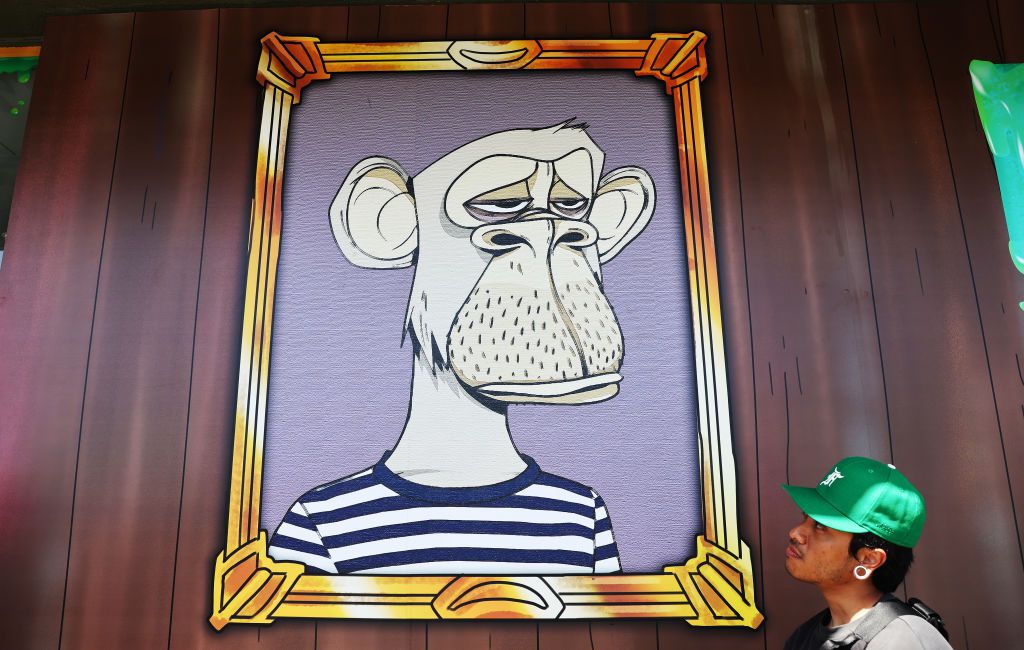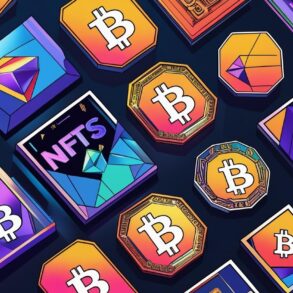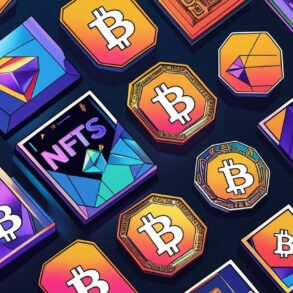
Non-fungible tokens can be created directly on NFT platforms, allowing you to mint (the process of creating or producing something) and upload your artwork on a blockchain. This guide will detail the steps needed to create your first NFT, including how to upload your artwork, choose the right blockchain, and where to list it for sale.
Key Takeaways
- Non-fungible tokens (NFTs) are unique digital assets that are stored on a blockchain.
- Creating an NFT allows users to upload unique digital media and sell it on an NFT marketplace while retaining copyright ownership.
- Multiple blockchains support NFT creation, with Ethereum being the most popular.
What Is an NFT and How Do You Create One?
A common misconception regarding NFTs is that the image, video, or other digital item is the NFT. However, the token itself is hashed information stored on the blockchain. The digital item, tagged with metadata, is stored somewhere else, like Amazon Web Services or other hosting services. This is why you can right-click on the picture on an NFT auction site and save it—it is only the image. But your copy does not have the data associated with the NFT, so you’re not the owner. In a sense, you have a forged copy.
A token, in this regard, is the item’s information hashed into an alphanumeric string. This token is stored on the blockchain and establishes ownership of a digital item.
It might help to consider that an NFT is like your car’s vehicle identification number (VIN). That number is stored in the manufacturer’s database with your information. It’s also stored by the DMV in the state you live in. So, the VIN is a token associated with your car. The car is stored wherever you parked it last.
Creating an NFT is pretty simple. It can be done on an NFT marketplace or crypto exchange that supports minting. Here are some general steps for making your NFT.
Step 1: Figure Out What You Want to Create
NFTs are typically tied to a piece of digital art and are associated with an ordinal sequence. This may be an image, an audio production (such as a song), or even a short video clip (such as an animated GIF). The goal is to create a unique piece of digital media that can be sold, just like selling a painting at an art gallery.
NFTs provide value to creators by being unique, something that cannot be owned by someone else. It is especially important to ensure that you own the rights to the digital media you use, as creating an NFT from media you don’t own may result in legal consequences from the rightful owner.
Step 2: Choose a Blockchain
There are several blockchains that can mint your NFT. This blockchain will keep a permanent record of it, so it’s important to choose the one that fits your requirements.
Ethereum
The most popular NFT blockchain is Ethereum, which hosts thousands of NFT collections. Ethereum NFTs are created utilizing the ERC-721 and ERC-1155 standards, which store the metadata of the NFT on the Ethereum blockchain. The ERC-721 standard was developed by the same teams that developed the ERC-20 smart contract and defines the minimum interface—ownership details, security details, and metadata—required for exchanging and distributing gaming tokens.
This blockchain currently operates using the proof-of-stake (PoS) consensus mechanism, making it much more eco-friendly than it used to be. Most NFT marketplaces support the creation of Ethereum NFTs, though transferring NFTs on the Ethereum blockchain may come with high gas fees.
Ethereum is used by other projects (called sidechains) for creating NFTs and cryptocurrencies. Polygon is one of the more popular sidechains for NFTs, used by some businesses and fans.
Solana
The nearest competitor to the Ethereum blockchain is Solana. Designed as a faster, lower-cost alternative to Ethereum, Solana offers transaction fees of less than $0.01 and a growing list of supported apps for NFTs. In addition, Solana utilizes both the proof-of-history (PoH) and PoS consensus mechanisms and boasts much faster transaction speeds than Ethereum.
Flow
Flow is another PoS blockchain designed for NFTs and decentralized gaming apps, and it is host to the popular NBA Top Shot NFT collection. Many other sports franchises have created marketplaces on the Flow blockchain, making it a popular place for sports-focused NFT creation.
There are several other blockchains that support NFTs, each with its own community and decentralized apps (dApps) for creators and NFT owners.
Step 3: Set Up an NFT Wallet
Once you choose a blockchain, you will need a digital wallet that supports that blockchain to store your NFT. To create a wallet, you will need to download the crypto wallet app and provide a username and password. You should also store any private keys and recovery phrases outside of the wallet (offline) for security and backup purposes.
There are several popular wallet apps that support multiple blockchains. Here are a few:
- MetaMask: MetaMask is a popular crypto wallet that supports a wide variety of cryptocurrencies, as well as both the Ethereum and Solana blockchains. It can be used as a mobile app or added as a browser extension.
- Coinbase Wallet: Coinbase offers a digital wallet that supports ERC-721 NFT tokens and Solana NFT collections. It can be downloaded as a mobile app or added as a browser extension.
- Ledger Nano X: If you want to store your NFT keys in a secure hardware wallet, the Ledger Nano X supports both Ethereum and Solana NFTs.
Step 4: Choose an NFT Platform
An ever-growing list of NFT platforms allows you to create an NFT, but the best ones offer a full-service marketplace to list and sell NFTs. Here are a few of the most popular NFT platforms:
- OpenSea: The most popular NFT platform by far is OpenSea. With more than $20 billion in trading volume since its launch in 2017 and more than two million NFT collections listed, OpenSea is the top platform for Ethereum-based NFTs. OpenSea launched support for Solana NFTs in July 2022.
- Solanart: As the Solana-based NFT platform, Solanart hosts some of the most popular Solana NFT collections, with a slick user interface and a simple application process for minting.
- Crypto exchanges: Several crypto exchanges support NFT creation, such as Binance Exchange. You can create your NFT directly on the platform, choose which blockchain you prefer, and mint or create the NFT directly.
Step 5: Create the NFT
Once you have chosen a platform, creating an NFT is pretty straightforward. Here is an example for creating an NFT on OpenSea:
- Connect your wallet: During your OpenSea account signup, you are prompted to connect your wallet. This will require you to sign a verification on your wallet app.
- Create a smart contract: In the OpenSea Studio, select “Create,” then “Create a new collection.” This brings up a page where you create a smart contract. You drag and drop your media, name the contract, choose your token symbol, choose your blockchain, and click continue. You’ll be prompted to sign it in your wallet.
- Create the NFT: Once you have created the collection, you’ll be taken to a screen to create an NFT. Click on “Create an NFT.” Here, you choose your NFT name and how many to make, add a description, and provide an external link if necessary or add traits. Browse for or drag and drop your media to the box, click “Create,” and sign in your wallet.
You may be required to pay any fees charged by the platform or blockchain for transactions and minting.
Step 6: List the NFT for Sale
Listing an NFT for sale is simple; some NFT platforms allow you to do this for free. Once your NFT is created and in your wallet, you can simply hit the “sell” button on the platform of your choice. Then, choose the price you wish to list it at and how long you want the sale to last.
Once the details of your sale are filled in, you can create the listing. This will require you to sign a few transactions in your digital wallet, which may include paying transaction fees on your chosen blockchain. Solana transactions are tiny, typically less than $0.01, while listing an NFT on the Ethereum blockchain can cost more, depending on the network fees at the time of listing.
How Much Does It Cost to Sell an NFT?
Once the NFT has been listed, it should have a unique URL you can share with others. Sellers pay a nominal fee to the NFT marketplace when a purchase is made; for example, Binance charges a 1% platform fee as well as other fees, while OpenSea charges a flat 2.5% of the sale price.
Gas fees paid to the blockchain will add to your costs. For example, OpenSea lists one-time and reoccurring blockchain costs that you might incur:
- The first time you list an NFT in a collection (one time)
- The first time you use a specific cryptocurrency (one time)
- Deploying a smart contract (one time, every time you deploy a new one)
- Buying an NFT (recurring)
- Transferring an NFT (recurring)
- Minting an NFT (recurring)
When you create the NFT, you can add in a royalty fee that pays you a percentage of the transaction each time your NFT is subsequently sold. Creators can earn up to 10% for every transaction.
Can I Create a Non-fungible Token (NFT) for Free?
Yes. Most non-fungible token (NFT) platforms allow you to create and list NFTs for free (but you might be charged gas fees). However, you’ll likely be charged a percentage os the sale price when you sell one.
How Do I Create an NFT Image?
The digital images you see in many NFTs are uploaded to an NFT platform, which hashes the information included with the image into a token stored on a blockchain. To create the image, you can take pictures with a camera or phone and use image software like GIMP or Photoshop to manipulate it. If you have digital art skills, you could create vector graphic images, draw on a graphics tablet, or create digital art in other ways. Then you use an NFT marketplace or other platform to upload the image and create an NFT.
Are NFTs Protected by Copyright?
Yes, unless they are subject to fair use laws. Copyright is granted as soon as an image, sound-byte, video, document, or other original work is created. The creator is the copyright owner. Purchasing an NFT does not convey copyright ownership; that still lies with the creator unless it is expressly transferred by the owner with the purchase.
The Bottom Line
Creating NFTs requires a basic understanding of minting, blockchain, crypto wallets, marketplaces, and gas fees. Once you understand how NFTs work, getting started with them is easy because most of the process is automated—except for deciding what to turn into an NFT.
The comments, opinions, and analyses expressed on Investopedia are for informational purposes online. Read our warranty and liability disclaimer for more info.
This post was originally published on this site be sure to check out more of their content







